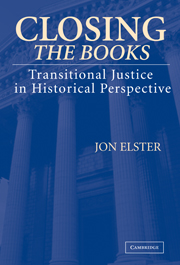PART II - ANALYTICS OF TRANSITIONAL JUSTICE
Published online by Cambridge University Press: 17 November 2009
Summary
In Part II, I try to impose some structure on the cases I surveyed in Part I. It is clearly time to delineate the idea of transitional justice in a more conceptual manner. This I try to do in Chapter 4. In the rest of the book, I offer elements of explanation to account for variations in transitional justice across time and space. I first discuss how the fate of wrongdoers (Chapter 5) and victims (Chapter 6) is determined by the priorities of legislatures, courts, and administrative agencies. In the following three chapters, I step back to consider the broader economic, social, and political forces that constrain and shape these decisions. The constraints are the topic of Chapter 7. In Chapter 8, I consider the emotional motivations that are pervasive in most cases of transitional justice. Chapter 9 considers the politics of transitional justice, whether based on interest or ideological motivations.
I do not aim at presenting a “theory of transitional justice.” As in my earlier work on local justice, I have found the context-dependence of the phenomena to be an insuperable obstacle to generalizations. The closest I come to a “law” of transitional justice is that the intensity of the demand for retribution decreases both with the time interval between the wrongdoings and the transition and with the interval between the transition and the trials (Chapter 8). Yet even here, we find that counteracting mechanisms may keep memory and resentment alive for a century or more.
Information
- Type
- Chapter
- Information
- Closing the BooksTransitional Justice in Historical Perspective, pp. 77 - 78Publisher: Cambridge University PressPrint publication year: 2004
